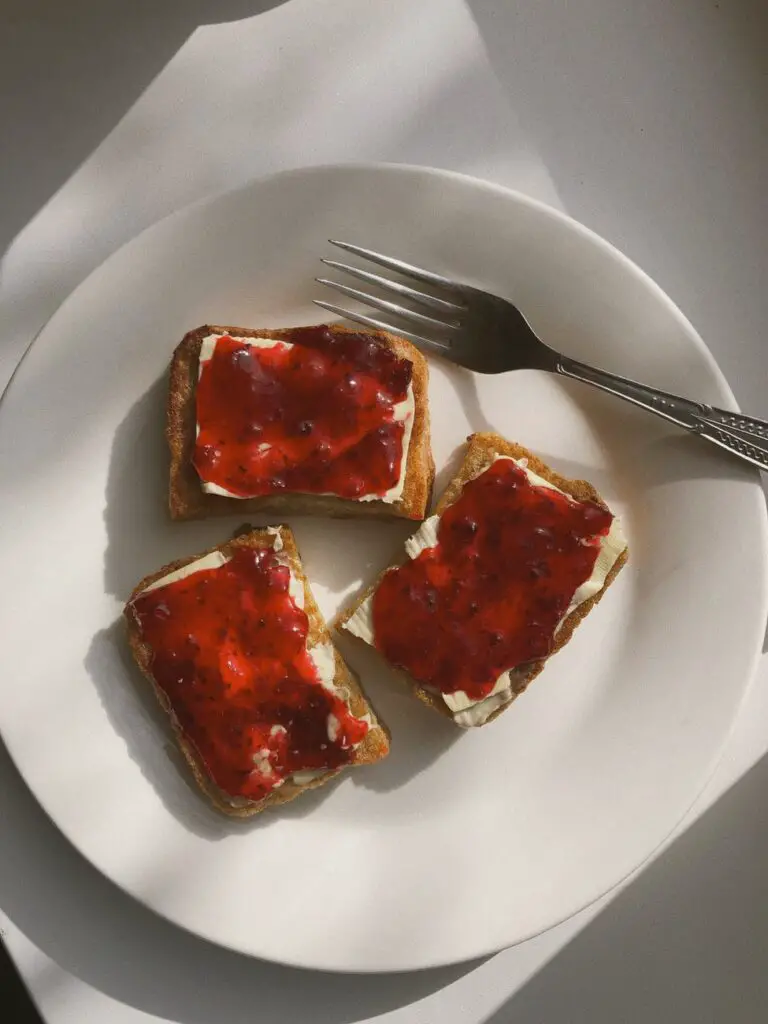We hope you like the products we recommend! Just so you know this post contains affiliate links and I will be compensated if you make a purchase after clicking our links.
We’ve caught our cat licking jam off knives before. Over the years, we’ve learned to hide knives and spoons from her. What’s interesting is that, according to research, cats can’t taste sweet things. We’d always assumed that our cat’s love of jam and peanut butter was because she liked the taste of sugar. We’ve also caught her eating wallpaper before, so maybe it’s not actually that strange.
Clearly our cat likes eating things, but can cats eat jam?
What is Jam?
Jam is a sweet condiment that’s known in North America as jelly. It’s made from fruit which is then heated and sugar is added. Jam is commonly spread on bread products or added to baked goods.
Can Cats Eat Jam?
There’s no nutritional benefit to cats eating jam, and we don’t advise that you feed it to your pets. If you’re anything like us, however, it’s probably more likely that your cat is stealing licks of jam rather than having it put in their bowl as a meal. So the good news is that there’s unlikely to be anything in jam that’s toxic. Always check the ingredients on the jar whenever your cat eats something that’s not intended for them.
One reason why you shouldn’t deliberately feed your cat jam is that it’s high in sugar. When cats have too much sugar, it can have a detrimental effect on a cat’s health — similarly to humans. It will cause a cat to gain weight, and obese cats are at greater risk of other chronic health conditions, some of which are life-limiting or life-threatening.
Jam obviously shouldn’t be given to cats with diabetes.
And sugar is also bad for your cat’s teeth. It can lead to cavities and dental issues, which aren’t only going to be expensive for you to fix but could make it difficult for a cat to eat.
But it’s not just the sugar in the jam that can be bad for cats. Sugar-free jam is a popular low-calorie option for people looking to limit sugar in their diet. The problem with sugar-free jam is that it may contain xylitol, which is a sweetener and toxic to cats and dogs. Suppose you suspect that your pet has consumed food containing xylitol. In that case, you contact a veterinarian because it can be fatal if untreated.
Again, always check the ingredients of whatever your cat eats.
Another common ingredient in a jam is citric acid. Citric acid is toxic to pets, but there’s probably not enough in jam for it to post harm to cats. Although, the amount of jam they’ve consumed will play a factor in this. There are signs of citrus poisoning, including vomiting and diarrhoea, so contact your veterinarian if you’re worried.
We wouldn’t recommend letting cats eat grape jam, either. Grapes are toxic to cats. They’d have to eat a fair amount of it but contact your veterinarian if you’re concerned.
Ultimately, cats can eat most kinds of jam (excluding jams containing xylitol and grape). Still, it isn’t something you should be encouraging your cat to eat. It shouldn’t be something you’re deliberately giving your cat regularly, either.
However, cats will be cats, and we know from experience that it’s not always possible to stop them from eating what they want.
We hope you’ve found this article helpful. We’ve written a few more that you may be interesting in reading, including Can I Feed My Cat Raw Meat From the Grocery Store and Why Do Cats Chew on Cardboard? And Cat Cakes Eat Raw Pork?
